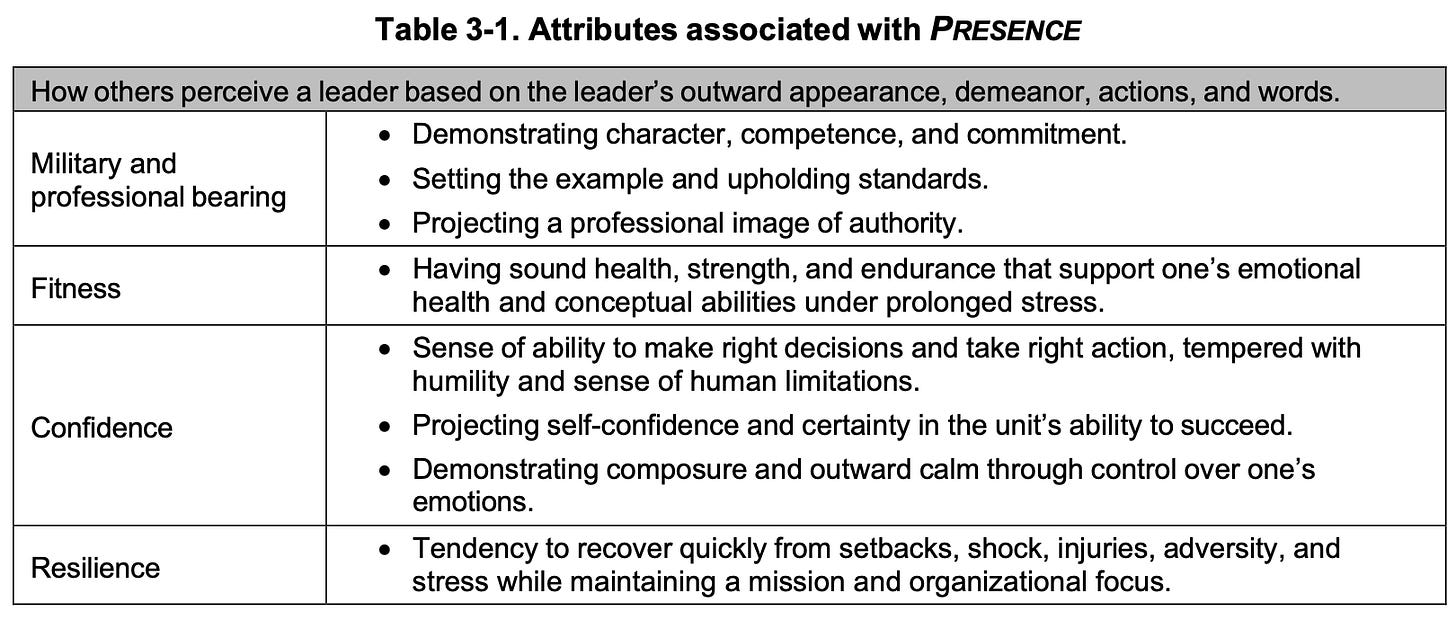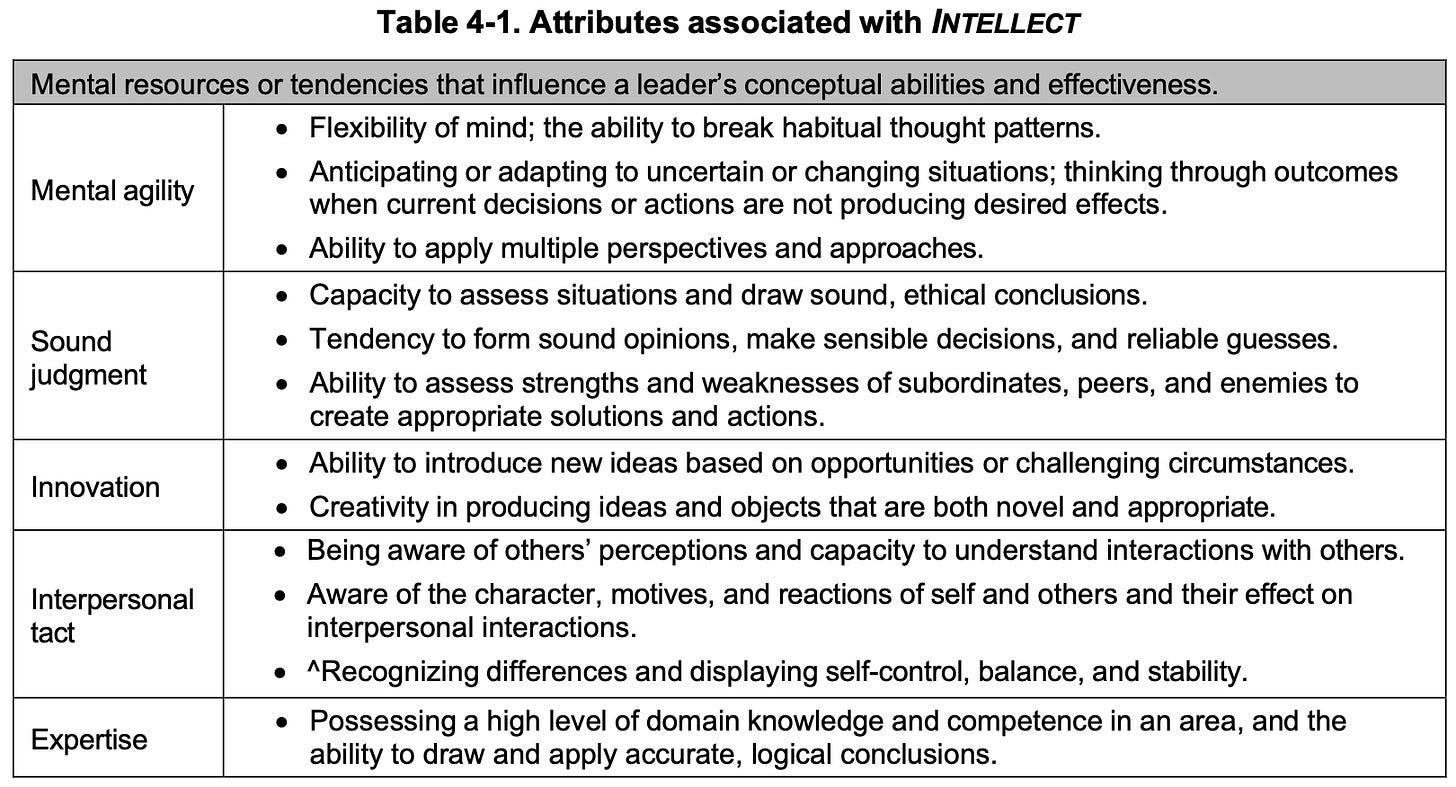Command Presence
Guided Discovery.

How do you act when everyone is looking?
Suggested Reading
ADP 6-22, Army Leadership and the Profession
Pages 3-1 through 4-5 based on printed document (PDF pages 53-61)
Discussing the US Army’s second and third critical attributes: presence and intellect
This week’s Study: Own the Room
All excerpts below are from ADP 6-22 unless otherwise noted
Introduction
3-1. Demonstrating presence is more than just showing up and being seen, although both are important. The actions, words, and the manner in which leaders carry themselves should convey confidence, competence, and a positive example for others to emulate. Presence represents who leaders are and what they stand for.
…
Part of projecting a positive leadership presence is being comfortable in one’s own skin. While leaders should understand that their subordinates are always observing how leaders carry themselves, they should also understand that subordinates can quickly tell the difference between leaders who are trying to portray themselves as something they are not.
…
Remembering that most subordinates want their leaders to be successful is important. When they sense that their leaders are genuine, honest, and willing to learn by putting themselves into positions where they might risk a little embarrassment learning a new skill, their level of respect for a leader increases. Leaders able to do what they ask others to do, who can ‘walk the talk,’ generate a positive reputation that contributes to their effective presence around Soldiers.
How do you act when everyone is looking?
Is there a correct balance between authentic presence and creating a persona?
How would your team describe your presence?
This Week’s Reading, Abridged
3-2. Through their presence, leaders show what they stand for and how they expect others to carry themselves. Leaders who routinely share in hardships and dangers have firsthand knowledge of what they are asking subordinates to do, and show their subordinates that they are not above putting themselves at the same level of risk or discomfort. It assures Soldiers that what they are doing is important. A leader’s effectiveness is dramatically enhanced by understanding and developing the following areas:
Military and professional bearing: projecting a commanding presence, a professional image of authority, calmness under pressure, and control over emotions.
Fitness: looking like a fit, professional Soldier, having the strength, and endurance to lead others from the front, and being physically able to do what subordinates are expected to do.
Confidence: projecting self-confidence and certainty in the unit’s ability to accomplish the mission, able to retain composure and demonstrate calm through steady control over emotion.
Resilience: demonstrating the psychological and physical capacity to overcome failures, setbacks, and hardship.
3-3. A professional military demeanor establishes credibility, sets expectations, and reduces organizational ambiguity. Consistent professionalism strengthens mutual respect among members of the team.
How do you know whether your presence inspires or intimidates?
What ratio (between bearing, fitness, etc) is the proper mix for your organization?
What situations challenge your ability to maintain consistency in presence?
3-5. Operations place physical, mental, and emotional demands upon the individuals conducting them. Physical fitness, while crucial for success in battle, is important for all members of the Army team in all environments. Physically fit people feel more competent and confident, handle stress better, can work longer more effectively, and recover faster from hardship.
3-8. It is a leader’s duty to stay healthy and fit since the leader’s decisions affect the welfare of the entire organization. Fit and healthy leaders motivate and challenge subordinates to become like them. Staying healthy and physically fit enables Soldiers to cope with the psychological effects of extended operations. To maintain peak performance, leaders and Soldiers need exercise, sufficient sleep, nutritional food, and adequate hydration.
3-10. Confidence is the faith leaders place in their abilities to make decisions and take appropriate action in any situation, no matter how stressful or ambiguous. Confidence grows from professional competence and a realistic appraisal of one’s abilities. A leader’s confidence is contagious and permeates the entire organization. Confident leaders who help Soldiers control doubt reduce anxiety in a unit. Effective leaders temper confidence with humility—the understanding that no one is perfect, all knowing, or always correct. Humility prevents overconfidence and arrogance.
Is physical fitness a leadership requirement or discrimination disguised as standards?
When does confidence cross into arrogance and who decides where the line exists?
4-1. Intellect is fundamental to successful leadership. Intellect consists of one’s brainpower and knowledge. Intellect enables leaders to think creatively and critically to gain situational understanding, make sound judgments, solve problems, and take action. Intellect allows leaders to reason analytically, critically, ethically, and with cultural sensitivity. Intellect is involved in considering the intended and unintended consequences of the decisions a leader makes. Effective leaders must anticipate the second- and third-order effects of their decisions.
4-2. A leader’s mental abilities affect how well they think and lead others. People differ in intellectual strengths and ways of thinking—there is no one right way to think. Each leader needs to be self-aware of their strengths and limitations and apply them accordingly.
4-5. Mental agility relies upon curiosity and the ability to reason critically. Inquisitive or intellectually curious leaders are eager to understand a broad range of topics and keep an open mind to multiple possibilities before reaching decisions. Critical thinking is purposeful and helps find facts, challenge assumptions, solve problems, and make decisions. Critical thinking enables understanding of changing situations, arriving at justifiable conclusions, making judgments, and learning from experience. Critical and creative thinking provide the basis for understanding, visualizing, and describing complex, ill-structured problems and developing approaches to solve them. Critical thinking provides a basis for reflection and continual learning. Creative thinking involves thinking in innovative ways using imagination, insight, and novel ideas. Critical and innovative thought are abilities that enable adaptability.
4-8. Often, leaders must balance facts, question assumptions, and sense intangible factors like morale or the enemy’s intent. Judgment contributes to the ability to compare possible courses of action and decide what one to take. There are times, particularly in combat, where there are no good decisions, only the least bad decision possible in the moment. Sound judgment requires consideration of consequences. It also includes the ability to assess strengths and weaknesses of subordinates, peers, and the enemy.
4-10. Innovative leaders prevent complacency by finding new ways to challenge subordinates with alternative approaches and ideas. They recognize that other people have good ideas and they recognize those who do. To be innovators, leaders rely on intuition, experience, knowledge, and input from subordinates, peers, and superiors. Innovative leaders reinforce team building by making everybody responsible for—and stakeholders in—innovation.
4-11. Effectively interacting with others is a skill that requires self-awareness. Interpersonal tact is a component of professional behavior. Interpersonal tact relies on understanding the character, reactions, and motives of oneself and others. It can be distilled down to the idea of honestly stating one’s views about an idea or another person as diplomatically as possible to ensure it is understood without causing unnecessary offense. Tact should be balanced by professional candor, in terms of saying what needs to be said or done for the good of the mission or the unit.
Does mental agility require abandoning deeply held convictions? What’s the balance?
Is expertise more dangerous than ignorance in rapidly changing organizations or industries?
How do you determine when to employ tact versus candor?
4-12. Personal perspectives vary within every individual human being and societal groups. Understanding the different backgrounds, qualifications, experiences, and potential of each of the individuals in an organization is an important part of being an effective leader. It is fundamental to knowing your people and harnessing their diverse skills and perspectives to build cohesive teams. Good leaders create conditions where subordinates know they are valued for their individual talents, skills, and perspectives that contribute to mission accomplishment.
4-14. A leader’s emotional state influences subordinates’ emotions. Balancing the right level and mix of emotions for a situation provides confidence.
4-15. Effective leaders can read others’ emotional states to employ the right balance of interpersonal tact and candor in a particular situation. They draw on experience to provide subordinates the proper perspective on unfolding events. They possess a range of attitudes, from relaxed to intense, from which to choose appropriately for the circumstances they face. Balanced leaders know how to convey urgency without throwing the entire organization into chaos.
4-17. Leaders have a moral obligation to those they lead to improve their expertise continuously. Leaders themselves should be open and eager to benefit from others’ knowledge to enhance their own tactical and technical expertise.
4-23. Army organizations operate around the world in a wide variety of environments with different unified action partners representing many different cultures. Leaders should acquire cultural and geopolitical knowledge about the areas in which they expect to accomplish the mission.
4-25. Culture consists of shared beliefs, values, and assumptions. Army leaders are mindful of cultural factors in three contexts:
Sensitivity to unified action partners’ backgrounds to determine how to best use their capabilities.
Awareness of the culture of the area in which the organization is operating.
Consideration of partners’ customs, traditions, doctrinal principles, and operational methods.
What cultural assumptions from your early life still influence your decisions?
How do you learn about and observe team members to accurately read their emotional states?
How do you act when everyone is looking?
Questions for Individual Reflection
Does authentic leadership require vulnerability or does this hurt presence?
Can you lead effectively if you've never performed the work you're asking of others?
When and how does interpersonal tact become manipulation?
Should leaders suppress their emotions or is emotional authenticity essential for trust?
Does innovation require destroying existing systems or can it coexist with stability?
Professional Discussion Prompts
How do you demonstrate presence in virtual environments when physical bearing is invisible?
Should executives be required to maintain the same fitness standards as frontline employees?
Should cultural sensitivity ever override organization objectives?
When should leaders admit they don't know something versus projecting confidence?
Is tactical knowledge relevant for strategic leaders or does it create opportunities for micromanagement?
Personal Discussion Prompts
How does your family members describe your leadership presence at home?
When has your professional confidence masked personal insecurity?
What aspects of your self and life do you suppress in professional settings?
When has resilience prevented you from seeking help you actually needed?
When has your need to appear composed prevented genuine connection with others?
Exercises
Presence Reflection
Exercise:
Each participant identifies three people who see them differently (a direct report, a peer, and a superior), then reflects on how their presence varies across these relationships
Share insights about when and why leadership presence shifts and explore whether variations represent authenticity or performance
Discuss whether consistent presence across all relationships is possible or even desirable
Debrief:
What does it mean that people experience different versions of your presence?
Are you adapting strategically or fragmenting authentically?
Tact Check
Exercise:
Each person identifies a recent conversation where they chose diplomacy (tact) over directness (candor)
Explore outcomes of that choice and whether tactful communication served the relationship or mission better
Examine cultural and generational differences in how directness is received within their organizations
Debrief:
When does interpersonal tact become a barrier to necessary truth-telling?
How do you calibrate honesty without sacrificing relationship quality?
Feel free to borrow this with pride and use with your teams, professionally or personally. If you do, please let me know how it went and tips for improvement: matt @ borrowingwithpride.com


